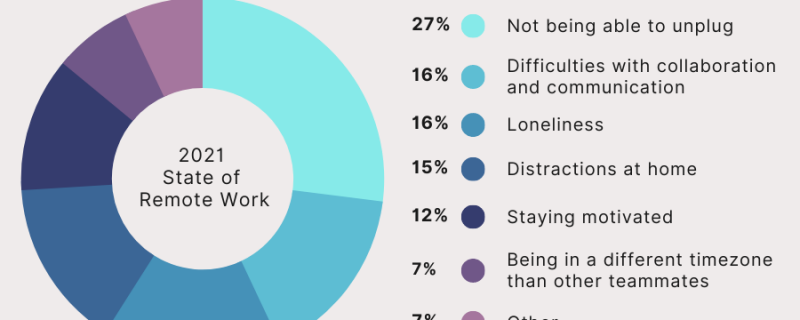Are You Micromanaging Your Remote Employees?
 Managing remote employees has been compared to driving on the left side of the road. You still have the same destination, but how you get there is completely different (i.e.-cues, controls, etc.) and there’s a learning curve to get used to. When remote work began suddenly four years ago, few managers were prepared for working with teams who were not physically in the office. Some adjusted fairly quickly, others struggled, but the one question on everyone’s mind was, “how do we continue to get our best work done?”
Managing remote employees has been compared to driving on the left side of the road. You still have the same destination, but how you get there is completely different (i.e.-cues, controls, etc.) and there’s a learning curve to get used to. When remote work began suddenly four years ago, few managers were prepared for working with teams who were not physically in the office. Some adjusted fairly quickly, others struggled, but the one question on everyone’s mind was, “how do we continue to get our best work done?”
If you’re in a management role, chances are you’re working with a number of employees who are remote or on a hybrid schedule. Do you still struggle to figure out how to get the “best work” from your remote and/or hybrid workers? Have you turned to using micromanaging tactics or are you tempted to give them a try out of sheer frustration? I have three words for you: Don’t do it!
Micromanagement symptoms include excessive email sending and a need to control every part of a project or team, no matter how small. Micromanagement is a far too common problem in many workplaces but, according to retention reports, it’s no longer a leadership style that younger generations, in particular, will stand for. In fact, nearly 3 out of 4 workers say micromanagement raises the biggest red flag about a workplace and almost half, 46%, say they’d leave a job because of it, according to a 2023 survey by Monster.com. Here are a few other signs of micromanagement:
- An inability to see the big picture and getting bogged down in the details
- Needing approval on every task
- An obsession with constant updates
- Difficulty delegating
- The need to be copied into every email
- A tendency to over-complicate instructions
- The belief that no one else is capable
Do any of these sound familiar? If so, we’ll look at ways to help with micromanaging team members in our next article. No doubt about it – it’s tough managing people who aren’t always in the office and the luxury of face-to-face interaction isn’t always possible. The first step is to look at why micromanaging is happening in the first place. There is no straight answer to that question. People micromanage for a variety of reason, such as fear of failure, need for control, inexperience in management, insecurities, lack of trust, unhealthy ego, etc. Some micromanagers might do it due to problems that they have at home and in their personal life.
With an increase in hybrid and remote work, some managers find themselves falling into the trap of micromanagement. But it’s dangerous territory, particularly in terms of team morale and retention. Working with a coaching firm, like Leah M Joppy and Associates, is a highly effective step towards helping leaders with any micromanagement issues. We can work with your management team on any challenges they’re facing leading a remote/hybrid team, get to the root causes of any micromanagement issues and implement ways to help. It’s an investment that will pay off in so many areas, including team member satisfaction and engagement. Call us at 301-670-0051 or email us at leah@lmja.com to learn more.
How To Control Micromanaging Tendencies
 Remote and hybrid work schedules continue to be very popular with both employees and potential new hires. However, one thing can quickly derail team member motivation and job satisfaction: micromanagement. We looked at some of the symptoms of micromanagement and a few of its causes in our previous article. But what are some effective ways of handling it? Leaders may be throwing up their hands when it comes to managing remote/hybrid teams and feel like they need to be monitored continuously. It’s challenging when people are scattered and you don’t have the luxury of face-to-face interaction.
Remote and hybrid work schedules continue to be very popular with both employees and potential new hires. However, one thing can quickly derail team member motivation and job satisfaction: micromanagement. We looked at some of the symptoms of micromanagement and a few of its causes in our previous article. But what are some effective ways of handling it? Leaders may be throwing up their hands when it comes to managing remote/hybrid teams and feel like they need to be monitored continuously. It’s challenging when people are scattered and you don’t have the luxury of face-to-face interaction.
Here’s a look at 5 ways to avoid crossing the line from supervision into micromanagement with remote and hybrid workers:
- Work on trusting your workers: This may be the golden rule for managing remote workers. Let your team members work through challenges and set up a schedule for check-ins with each team member to have a regular method for interacting with them.
- Be flexible: Give people the opportunity to work when, where and how they can be most productive.
- Empower your team members: Make sure team members clearly understand what is expected of them and communicate how their activities are vital to meeting your organization’s goals. Finally, provide team members with the resources they need to get the job done.
- Focus on outcomes: Don’t obsess over the time your team spends getting the job done or how they do it. What matters is that they get results on the agreed-upon schedule.
- Do not blame: Blame is one of the fastest ways of demoralizing your teams’ self-esteem and a sure-fire way to ruin trust. Instead, focus on the lessons learned from failures and let your team come up with the solutions to do better next time.
Finally, ask how your team will benefit from your engagement, not how you will benefit from engaging with your team. And remember that leaders who make an effort not to micromanage their remote workers will have more successful teams in the end.
The future is remote/hybrid work within the federal government promises to be ever-changing in the months (and years) to come. One thing we’ve learned is to expect the unexpected. Whatever changes or challenges that come down the line, Leah M Joppy and Associates is ready to help. Whether it’s management issues like we discussed above or ways to help remote/hybrid teams be more engaged and productive, we can work with your organization to provide solutions with real results.
Why Some Managers Are Resistant To Work Schedule Flexibility

For many organizations, work schedule flexibility is a new part of their compensation package. It’s a powerful tool in terms of employee engagement, retention and recruiting. Remote and flexible schedules have shown to not only provide employees with higher job satisfaction, but better health, less absenteeism, increased work-life balance and less stress. This is all well and good for workers, but what do managers really think about remote work? While many understand the appeal and benefits, it’s still difficult to embrace change and work through the challenges of managing a remote and/or hybrid team.
Here’s a look at 7 reasons why managers may be resistant to remote work:
- Lack of accountability and supervision: Sure, some team members work well (and in some cases better) working remotely. Then there are those that struggle with time management, distractions and other challenges. Managers may feel that it’s more challenging to supervise employees and keep them accountable when they’re not physically present in the office.
- Loss of collaboration: Face-to-face interaction is often believed to foster a more cohesive work environment. Some managers worry that remote work can make it harder for team members to truly feel like a team. This is of particular concern for new team members and younger workers who are just starting out in their career.
- Lack of company culture: Strong in-office culture can be a key component for an organization’s retention and recruitment. Managers may worry that remote work could be a hinderance towards building this culture.
- Increase in security concerns: There may be concerns about the security of data when employees are working outside the office.
- Decrease in productivity: Some managers may feel that team members are more productive in a controlled office environment. Working from home can potentially have more distractions and chances to break from a traditional work schedule.
- Concerns about equity: In some settings, not all roles can be performed remotely or on a hybrid schedule. Allowing some employees to work from home might create perceived (or actual) inequities among team members.
- Holding onto a traditional mindset: Some managers may still have a traditional view of work that involves all team members being present at a common workplace. Change is hard and personal experiences and beliefs take time to overcome, particularly when it comes to management practices.
As we discussed last month, an annual government-wide survey conducted by the Office of Personnel Management found that more than two-thirds of federal employees are still teleworking at least occasionally. Remote and hybrid work isn’t going anywhere, but neither are the management challenges if your organization doesn’t face them head on. Leah M Joppy and Associates can help you figure out your primary challenges and work with you and your team to make remote/hybrid working a more efficient, productive and collaborative experience!
Call us at 301-670-0051 or email us at leah@lmja.com to learn more.
Why Some Employees Find Remote Work To Be A Challenge

When we think of remote work, many of us think of meetings in our sweatpants, the ability to schedule appointments when we want and not having to sit in traffic for hours. For many, a remote or hybrid schedule is like a dream come true. We’ve looked at the variety of benefits in past articles, among them: work/life balance, increase in productivity, no commute, increased flexibility and autonomy and so much more. And we’ve looked at why offering a remote and/or hybrid schedule is an incredibly effective recruiting and retention tool. But even with all the positives, remote work can present a whole new set of challenges for some employees. Let’s take a look at some of the top 5 remote work complaints:
Con #1: Social isolation
This is probably the number one complaint that employees have about remote work, particularly new workers and young workers who are new in their career. It may be challenging to build strong relationships with colleagues without face-to-face communication, resulting in a sense of disconnection from the team. Social events like happy hours that were once spur of the moment and easy to plan, now take more effort and can end up on the backburner.
Con #2: Work-life boundaries are blurred
While some feel one of the biggest benefits of remote work is work/life balance, others have difficulty unplugging from the office and feeling like they’re always “on call”. It can be difficult to disconnect from work and take breaks when workspace is also a private space. This lack of separation can negatively impact mental well-being if not managed effectively and can lead to burnout.
Con #3: Communication and collaboration are limited
Zoom meetings are all well and good, but some aspects of face-to-face interaction can’t be done remotely. Remote work can make it challenging to build trust through in-person interactions. Some team members may also feel like their access to mentorship, networking and senior leadership opportunities are more limited.
Con #4: Risk of miscommunication
Remote work often involves written communication, which can sometimes lead to misunderstandings or misinterpretations. It may be challenging for remote workers to resolve conflicts effectively without the benefit of immediate in-person conversations.
Con #5: Lack of focus and distractions
While the typical distractions of the workplace may be eliminated, remote work introduces a new set of distractions at home. It’s easy to be distracted from work tasks by household chores, family members or other personal issues. Some workers may not have the space to exclusively dedicate to a home workplace and have to work in busier areas.
Each of us has a unique personality and work style. For every person who enjoys the solitude of working remotely and the freedom that it provides, there’s another who thrives on human interaction or craves the routine and structure of going into the office. That’s why management plays such an important role in implementing a strategic remote/hybrid work strategy and communicating it effectively with team members. Leah M Joppy and Associates is ready to help you reduce the cons of remote work and ensure that team members feel supported and engaged.
Contact us at 301-670-0051 or email us at leah@lmja.com to learn more and get started.
Social Media Content: Career Advice For The Younger Generation?
 Whether you love or hate social media or choose to not participate altogether, there’s no question it has a profound influence on younger generations. It’s a part of life for Gen Z and doesn’t just affect their buying habits and pop culture tastes. It’s also where they often turn for career advice.
Whether you love or hate social media or choose to not participate altogether, there’s no question it has a profound influence on younger generations. It’s a part of life for Gen Z and doesn’t just affect their buying habits and pop culture tastes. It’s also where they often turn for career advice.
In October 2023, ResumeBuilder.com surveyed 1,000 full-time workers aged 21 to 40 regarding how TikTok has influenced their career decisions. The numbers speak for themselves. No surprise here: Gen Zers are more likely to make decisions based on TikTok creators. The survey revealed about 41% of those who use TikTok have made career decisions based on information they’ve seen on the app. At least 88% of people who took TikTok advice said it had a positive impact on their lives, 10% said it was neutral and just 2% said those decisions worked out negatively.
Last month, we looked at several TikTok employment trends that gained popularity last year, including “Quiet Quitting”, “Lazy Girl Jobs” and “Bare Minimum Mondays”. All three involved Gen Z’s quest for work/life balance, setting boundaries and sticking to their job description. Here are two other big employment trends that organizations should be aware of as they look to attract and retain the next generation of workers:
- “Managing Up”: This is by no means a new concept, but it took TikTok by storm last year. The hashtag #managingup currently has 5.5 million views and career advisors on the platform are promoting it as a key to making your job suit your needs. “Managing up” is understanding your manager’s working style and adjusting your own approach to make both your day-to-day jobs easier. Essentially, it’s about creating, maintaining and improving a working relationship with your boss.
- “Boreout”: What do you do when you realize your dream job isn’t all it’s cracked up to be? For Gen Z, it’s airing your frustrations on platforms like TikTok. The hashtag #boredatwork had about 470 million views as Gen Zers shared the mundane and repetitive aspects of their job. This disenchantment is often called “boreout” and can be equally as harmful as burnout. Lack of stimulation in a role can lead to negative feelings about an organization and higher rates of turnover.
Keeping up with social media employment trends can seem like an impossible task, particularly when they seem to change by the day. But when it comes to what Gen Z is looking for in the workplace, the message is pretty clear: work/life balance is key, meaningful work is important and flexible schedules are in demand. How can your organization attract and retain Gen Z workers? It’s one of the top questions Leah M Joppy and Associates receives from clients.
While LMJA realizes the federal sector has little flexibility in hiring practices, we have been very successful with helping our federal customers make minor tweaks in the interview process that can increase the chances of selecting a successful candidate that will stay around awhile! We’re ready to improve your 2024 recruitment strategies with tactics that will help you understand this younger generation and what they really want in the workplace.
Want to learn more? Call us at 301-670-0051 or email us at leah@lmja.com.
How Effective Is Your Collaboration?
 When your team works with other departments on a project, how would you rate your collaboration efforts? Is there an open line of communication and a real effort to identify issues and solve them? Or are you just “getting along” and that’s about it. Collaboration across departments or organizations is about more than just “cooperating” with other teams. It’s vital to develop a shared vision, cultivate mutual respect and have an understanding of each other’s roles.
When your team works with other departments on a project, how would you rate your collaboration efforts? Is there an open line of communication and a real effort to identify issues and solve them? Or are you just “getting along” and that’s about it. Collaboration across departments or organizations is about more than just “cooperating” with other teams. It’s vital to develop a shared vision, cultivate mutual respect and have an understanding of each other’s roles.
Effective collaboration among teams has a number of benefits, including:
- Helps to build trust and strengthen relationships within teams and across departments.
- Leads to decisions that benefit both the departments and the entire organization.
- Promotes learning and communication through the information exchange.
- Encourages individuals and teams to work together to identify concerns and come up with proactive solutions.
On the other hand, there are a number of issues that can creep up when collaborative efforts between departments are not a priority or break down all together. A few of the biggest offenders include:
- Inability to consider other perspectives: Team members can become so focused on their own job and their own team that they don’t take into account the different needs of other departments with different functions. You can overcome this challenge by having workers spend more time learning and understanding the role of other teams within the organization, perhaps through job shadowing or training opportunities.
- Ineffective meetings: Meetings are an important tool for communication, but if they’re not run properly, they can be a big waste of time. When it comes to meetings, carefully consider the objectives, draft a clear agenda and have a plan in place to follow up on actions determined at the meeting. Make sure someone is in charge of the meeting who can keep it on time and stop it from getting sidetracked. For cross departmental collaboration to be effective, you need to ensure you have the right teams and the right team members in attendance.
- Lack of clear direction: This is another pitfall of poor communication and one that can lead to confusion, frustration and resentment. When it comes to cross departmental collaboration, define roles and responsibilities from the beginning and make sure they’re communicated clearly. It’s the team leaders’ responsibility to address questions and concerns and check in regularly to make sure team members continue to understand what they’re contributing to the project.
When organizations embark on projects without the proper consultation and collaboration between departments, it can lead to confusion, wasted time and resources, lost productivity or, at the very worst, a failed outcome. Working with a coach, like Leah M Joppy and Associates, can make sure you get started on the right path from the very beginning. We’ll help you navigate every step of the process, including how to build an effective communication plan to defining team roles and so much more.
Coaching is a powerful tool for driving collaboration and improving overall team performance. If you’re interested in boosting your collaboration efforts when working with other departments or organizations, contact us at 301-670-0051 or email us at leah@lmja.com to learn more.
Guidelines Designed To Help Your Organization Enhance Collaboration
 When it comes to collaborating with your own team, it can often seem like a no-brainer. You know everyone’s role and communication style, your meetings are fairly predictable and everything seems like it’s just humming along. But when you add another department or organization into the mix, it can really throw you for a loop. The dynamics are different, you don’t know everyone’s work style and communication can seem like a struggle. It can test both your team members and your leadership skills. However, if you build the foundation for strong cross department collaboration at the beginning of a project, it can make all the difference.
When it comes to collaborating with your own team, it can often seem like a no-brainer. You know everyone’s role and communication style, your meetings are fairly predictable and everything seems like it’s just humming along. But when you add another department or organization into the mix, it can really throw you for a loop. The dynamics are different, you don’t know everyone’s work style and communication can seem like a struggle. It can test both your team members and your leadership skills. However, if you build the foundation for strong cross department collaboration at the beginning of a project, it can make all the difference.
In our last article, we looked at the benefits of effective collaboration among departments, as well as the biggest offenders that lead to communication breakdown. What are some ways to enhance collaboration and avoid any pitfalls? Here’s a look at the top 6:
- Make sure everyone understands the overall objective and their role in it: We touched on this in our last article. If team members don’t understand their role and the common goal they’re working towards, it can really derail a project. Clear communication from the top is so important and it starts with strong leadership and transparency.
- Encourage consistent communication and feedback: Communication comes from the top. Leaders must create clear systems to make this happen and build a culture where team members feel comfortable providing feedback.
- Create a culture of collaboration and community: Casual get-togethers and other team-building opportunities are an important part of the collaboration process. More and more teams and departments are working remotely or on a hybrid schedule, adding another layer of challenges. Leading teams that are both remote and in-person work best when remote workers are encouraged to see and interact with the larger department teams.
- Get to know the way other departments work: Team members can’t collaborate effectively with other departments if they don’t understand what they do and their work style. Make sure your team members aren’t working in a bubble and have opportunities to job shadow if needed, get involved in other departments’ processes, etc.
- Share technology and information: Make sure each team has access to the same types of data, people, tools, etc. This keeps the lines of communication open and makes it easy for teams to approach one another if they have access to the same information.
- Celebrate successes: Taking time out to recognize team members’ contributions goes a long way towards building morale. And it doesn’t have to be at the end of the project. Celebrating milestones throughout the process is a great way to keep everyone motivated.
Collaborating across departments or organizations can seem like an uphill battle, but with the right coach by your side, it doesn’t have to be. Leah M Joppy and Associates can work with you to improve your collaboration efforts and ensure that there’s transparent communication, efficient processes and strong leadership at the helm. When collaborative efforts are working effectively, team members feel that their voice is valued, they’re more engaged, more receptive to ideas and more likely to do their best work. And who doesn’t want that?
Are you ready to learn more? Call us at 301-670-0051 or email us at leah@lmja.com.
When It’s Challenging To Recruit, Consider The Assets Of The Department
 It’s no secret that it’s getting more and more challenging to recruit, hire and retain employees. You may wonder how you can compete, particularly when other organizations may be willing to offer higher compensation. However, salary isn’t the only factor that job seekers look at when searching for a new position. So many other variables come into play, like a department’s culture, flexibility and an emphasis on well-being. The key to making your open positions stand out is to tell your unique story in a clear and effective way through a strong employee value proposition.
It’s no secret that it’s getting more and more challenging to recruit, hire and retain employees. You may wonder how you can compete, particularly when other organizations may be willing to offer higher compensation. However, salary isn’t the only factor that job seekers look at when searching for a new position. So many other variables come into play, like a department’s culture, flexibility and an emphasis on well-being. The key to making your open positions stand out is to tell your unique story in a clear and effective way through a strong employee value proposition.
What is an employee value proposition (EVP)? Simply put, an EVP communicates the value an employer provides to its employees. Some of these assets may be beyond your control, but others can be emphasized by good leadership and professionalism. The most compelling EVPs include tangible assets, like benefits packages, and intangible values such as professional growth opportunities. The more benefits of working for your organization that you provide, the stronger your EVP is when hiring new team members.
No matter the state of the job market, an effective EVP is a vital tool for talent acquisition. It encompasses the assets you offer as an employer to attract new talent and retain your best employees. Here’s a sample of three sections every good EVP should have:
- Benefits and Perks: According to a Glassdoor survey, 80% of employees value stronger benefits packages over pay increases. Employee benefits are an important part of a good EVP and you should be clear about what you offer. Here’s a sample of what you can include:
- Health insurance policy
- Childcare
- Sick leave
- Parental leave
- Paid vacation
- Retirement plan
- Career Development Opportunities: Providing employees with the opportunity to learn new skills shows them you’re invested in their success. Career development options could include the following:
- On-site training opportunities. We can help reinforce training for your group!
- Tuition assistance.
- Coaching opportunities. LMJA also offers coaching to groups or individuals.
- Certification programs.
- Organizational Culture: Unlike the last two examples, an organization’s culture isn’t tangible, but that doesn’t make it any less important. In fact, cultural fit is key when attracting and retaining employees. LMJA and Associates is particularly helpful in developing and maintaining an attractive culture. Here are some ways to showcase your organization’s culture:
- Hybrid and remote work opportunities.
- Flexible hours. Can a new employee work around hours that fit his/her schedule more easily?
- Teamwork values. How effective are your teams? True teamwork increases work satisfaction. We can help with quality team management.
- Diversity and inclusion statements. The value of diversity has increased in the last few years. LMJA can help here too.
- Management style. LMJA has several courses aimed at building exceptional leadership skills.
- Well-being perks.
With available jobs seemingly outpacing the number of candidates, it’s more important than ever for organizations to attract and retain talent. That’s why it’s vital for organizations to develop a compelling EVP and then effectively communicate it both internally and externally. It can seem like a daunting task, but Leah M Joppy and Associates can help you create an EVP and add various strengths throughout the department. Through these efforts, you have the ability to tell your organization’s unique story and why potential new hires should work for you! Contact us at 301-670-0051 or email us at leah@lmja.com to learn more and get started.
The Composition Of An Effective Team
 Have you ever been a member of (or led) an exceptional workplace team? What are some of the positives that come to mind? Was it engaging and collaborative? Did you meet and exceed your goals? Did everyone feel valued and appreciated? It’s a great feeling, isn’t it? Yet all too often, teams fall short of being as effective as they can be and reaching their potential. The impacts are felt by employees, leaders and organizations as a whole.
Have you ever been a member of (or led) an exceptional workplace team? What are some of the positives that come to mind? Was it engaging and collaborative? Did you meet and exceed your goals? Did everyone feel valued and appreciated? It’s a great feeling, isn’t it? Yet all too often, teams fall short of being as effective as they can be and reaching their potential. The impacts are felt by employees, leaders and organizations as a whole.
So, what exactly do we mean by an “effective team”? It’s the capacity of a group of people, usually with complementary skills, to work together to achieve its goals and objectives. And it’s one of the biggest indicators of an organization’s success. According to Gallup, teams that rank in the top 20% for connectedness see 41% less absenteeism, 59% less employee turnover and a 66% increase in employee wellness. With numbers like that, it’s hard to argue that high performing teams are an integral part of your organization and worth the investment to develop and nurture.
Teams are as varied and unique as the people within them, but when it comes to effective, high performing teams, there are some common characteristics:
- Clear, achievable goals
- A shared commitment
- Clarity of roles and responsibilities
- A sense of purpose
- Clear processes and procedures
- Joint accountability
- A result-oriented approach
Effective teams also tend to show greater resilience by working through challenges and bouncing back from adversity. They also tend to maintain vitality and the energy needed for future success.
It’s no surprise that an effective team is only as strong as the person leading it. In our next article, we’ll get into more about what it takes to lead a high-performance team. The right leadership enhances a team’s success, but far too often, people are placed in leadership roles without any proper leadership development training. It’s vital for leaders to take advantage of every opportunity to enhance their leadership skills. However, it’s also vital for organizations to provide these opportunities in the first place. Working with a coach like Leah M Joppy and Associates can help your leaders identify their strengths and weaknesses and develop the skills needed to build effective teams (strong communication, building trust and resiliency, defining roles and responsibilities and so much more).
Do you want to lead a high performing team, but don’t know where to start? Contact Leah M Joppy and Associates at 301-670-0051 or email us at leah@lmja.com to learn more and get started.
Top Five Suggestions For Leading An Effective Team
 Today’s leaders often feel like they’re in a never-ending game of tug-of-war. Between dealing with day-to-day obstacles, managing projects and team members, it can be overwhelming. The “people” component is certainly the most integral to an organization and can prove to be the most challenging. Building a high-performing team is more than just putting together a group of talented people with the right skills. It requires careful development of each member’s unique talents and characteristics.
Today’s leaders often feel like they’re in a never-ending game of tug-of-war. Between dealing with day-to-day obstacles, managing projects and team members, it can be overwhelming. The “people” component is certainly the most integral to an organization and can prove to be the most challenging. Building a high-performing team is more than just putting together a group of talented people with the right skills. It requires careful development of each member’s unique talents and characteristics.
There is so much strong leaders can do to build effective, high-performing teams. Here’s a look at the top five suggestions. But remember, it’s a marathon and not a sprint. It’s a continuous process and not a “one and done” task:
- Establish meaning and purpose: It’s a leader’s job to help employees and teams find meaning in their work. To increase productivity and motivation, have discussions about the “why” of your team’s tasks. Team members who are passionate and motivated help drive team effectiveness because they understand how their work contributes to the organization’s overall objectives.
- Define roles and responsibilities: Leaders must ensure that everyone on the team knows exactly what is expected of them. It reduces confusion and conflict and allows teams to work more efficiently. Role clarity also enables leaders to hold team members accountable for their performance and identify areas where someone may struggle.
- Communicate effectively: Effective communication and effective leadership are definitely intertwined and it can make, or break, a team. As a leader, it’s vital to: practice active listening and allow people to give constructive feedback without fear of repercussions; ask questions and don’t be defensive; have an open-door policy; follow through with actions.
- Focus on building relationships: Building relationships helps to create (or reinforce) an organization’s values and culture. Once leaders and team members genuinely trust and respect each other, regular, open dialogue about individual and team performance increases team effectiveness.
- Provide productive, specific and timely feedback: Feedback is critical to improving performance, but how you deliver it can make a big difference. Productive feedback enables team members to see their successes and missteps and grow from the experience.
To build high-performing teams, organizations must cultivate high-performing leaders. People skills typically account for 80 percent of success in a leadership role. Yet many people are promoted into leadership because of their technical capabilities, without mastering the skills of managing and motivating others. Without these basic skills, leaders at every level can struggle with building high-performing teams. Leah M Joppy and Associates understands the challenges that accompany leadership roles and knows the proven techniques for building strong leaders who can build motivated, productive teams.
Ready to learn more? Call us at 301-670-0051 or email us at leah@lmja.com.